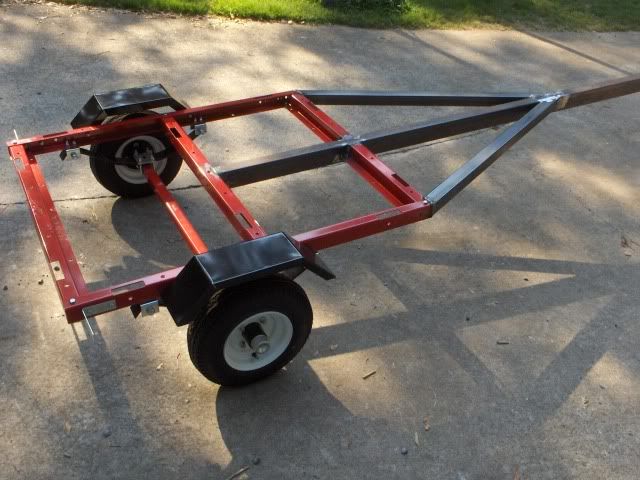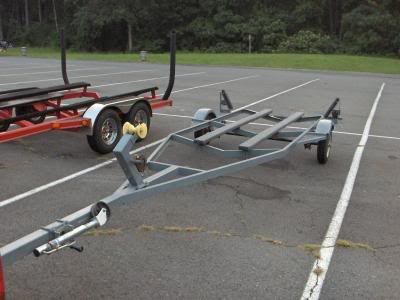|
|
Post by bassboy1 on Jul 22, 2009 0:53:46 GMT -1
Here is another slightly smaller one I am currently working on for a customer. I am almost completed. Just need to mount seat bases, and finish off the trailer, as well as get some pictures of the trolling motor foot pedal well. shareaproject.com/pages/projectTut,p,528,00.html |
|
hockeyruss123
Executive Member
he shoots... he scores!!
Posts: 2,145
|
Post by hockeyruss123 on Jul 22, 2009 1:23:16 GMT -1
so far it looks good dawson!!! i seen in california where people welded on the frame of the trailer as what seen in your photo... (the supports that y off the main of the tongue, which i think yours will be fine since it for a jon boat) where they had the trailers used as utility trailer fold in half on the freeway due to over loading the tongue area of trailer.... so if anyone goes and buys a trailer i would recommend to pay attention to this area if you plan on using trailer for serious loads...if so your section should y and go under the trailer for more support and not rely on someone weld.... just another thing welds never break.. its the penetrated area that failed.. as weld wasn't hot enough to penetrate material
|
|
|
|
Post by bassboy1 on Jul 22, 2009 3:35:04 GMT -1
I too have seen what you are talking about, usually on smaller enclosed trailers. Basically, the tongue, be it a straight one, or a V shaped tongue, is butt welded to the rest of the frame. It may not have been clear in the picture, but the front crossbar of the trailer was cut to allow the tongue to run continuously to the second crossbar. Then, the back of the tongue was welded to the middle crossbar, and the two sections of the front crossbar were welded to either side of the tongue. There is no cut on the tongue anywhere between the second crossbar, and the coupler.  Thus, for the tongue to fold up, it would have to fold at the front cross bar, both breaking each weld of the V, and folding the piece of 2 x 3 that is the tongue, as it is also welded on further back. Or, it would have to break the weld holding the tongue to the second cross bar and bend both red side channels. If I had not cut the first cross bar and extended the tongue to the second one, and instead but welded the tongue to the front bar, just as I had on the Vs, I could see your concern, as every bit of vertical load would be placed on 3 linear welds. The key is to make the welds on the tongue and V pieces be nonlinear, so the vertical load would have to break welds that are on 2 separate planes (at least on one dimension), which isn't going to happen with the loads this trailer is rated for. Not saying it wouldn't bend, but it would take forces much greater than the max rated load for any part of the trailer to do so. Probably would break if we put a 21 foot bass boat on it, but then again, the 21 foot bass boat trailer would break if we put a Caterpillar D8 Dozer on it, so it is all relative. Now, I see a lot of trailers that are designed with the same failure spot as you mention. 95% of these are storebought trailers. Take the trailer that is under my boat as an example. It is a 1981 model factory made trailer, that I cannot remember the brand of, for whatever reason.  This trailer, along with an Ezy Rider we have for an Alumacraft 18 footer, are made with a design flaw, at least in my opinion (I like things to be overbuilt, not merely adequate). The point at which the side bars of the frame bend is just V notched, then rewelded. But, the tongue does not extend past that point. Thus, when the boat is off, my trailer has a lot of flex. Towing it down bumpy gravel roads empty, you can see that in the mirrors, or by walking down one of the frame rails. When the boat is on, it is not a problem, as the boat is strapped down front and back, stiffening up the trailer. However, I would not tolerate such on a flatbed trailer, where the load is not a continuous piece, like a boat, but numerous individual pieces. On my gray trailer, the stiffening solution would be to have the tongue extend back to the first full width cross bar, and ideally placing said crossbar 1 foot aft. This would make 3 nonlinear welds, which even with bad penetration, are significantly more structural, than linear ones. But, the reason most trailers are made like my gray trailer as opposed to my method is the desire for dropped crossbars, and the impracticality of bending the tongue downward to meet those. I may be young, but I've certainly done my homework on this topic. ;D  |
|
hockeyruss123
Executive Member
he shoots... he scores!!
Posts: 2,145
|
Post by hockeyruss123 on Jul 22, 2009 20:26:13 GMT -1
did you weld that red trailer? or did your dad do it? he was looking at the whale tail i have on my motor and asked if i tigged welded that... he was commenting how good it looked... i didn't weld it but a friend did... i haven't expierenced with aliminum tig welding as of yet...  |
|
|
|
Post by bassboy1 on Jul 24, 2009 15:58:07 GMT -1
I did the red trailer. I have been proficiently MIG welding steel for about 6 months now, and am starting to MIG weld aluminum. I want to build the boat in the link (well, my version of it - I am going to be redrawing the entire hull, as I want a 15 - 16 degree deadrise as opposed to 12, as well as a 2 foot motor "pod" and a few other structural changes), before I graduate. glen-l.com/designs/hankinson/slither-snakeshtr.htmlOn boat hulls like that, TIG is way to slow, given that there are thousands of feet of weld. Thus, almost all the welds on aluminum hulls are MIG welded. I would love to be able to play around with a TIG on some thinner aluminum, but for practicality's sake, as well as cost's sake, the MIG is much more practical for my purposes. We have the aluminum wire feed equipment, which is alright for learning and small work, but aluminum wire doesn't like to feed, especially around bends, so before I start on the boat, I will be getting a spool gun. It will allow for a much longer lead, and working in tighter spots where the wire feed would kink and jam up. Ideally, I would like a push - pull setup, like the Lincoln 350MP, but I am having a tough enough time just obtaining the money needed for the hull - a 5000 dollar welder is certainly not in the cards. |
|
hockeyruss123
Executive Member
he shoots... he scores!!
Posts: 2,145
|
Post by hockeyruss123 on Jul 24, 2009 19:20:04 GMT -1
if you get good enough you could tig alunimum pretty fast but the only problem is constantly getting new filler rod it probably look nicer.. i never seen any one use mig alu w/out having a alu spool gun.. since its right there on the gun itself...
|
|
|
|
Post by bassboy1 on Jul 25, 2009 3:19:14 GMT -1
if you get good enough you could tig alunimum pretty fast but the only problem is constantly getting new filler rod While I could TIG fairly quickly when proficient, I can go faster yet with the MIG setup once I gain more proficiency. I know of very few people, and no companies, that TIG hull welds. I would love to have access to a TIG for above deck stuff (railings, T-Top and the like), but that isn't going to happen. The biggest issue is I have no TIG setup, and they cost a pretty penny that I haven't got. Later in life, I certainly will have one, but trying to merely buy the aluminum needed to build that hull, much less the motor and all needed to fit it out, on a high school student's budget, is hard enough without a new welder coming into play. I have recently seen one setup owned by a home boat builder in Alaska, that struck my fancy. It is a TIG spoolgun setup. Instead of using rod, it used wire on the standard small spools. There is a set of guides that runs the wire around the side of the gun, up to the electrode, and the distance from the wire to electrode is adjustable. He claims he gets TIG quality welds with MIG speeds. Also, because it is feeding the wire, as opposed to feeding with the other hand, he gets a more even weld, as it virtually eliminates the human error part. It isn't easy, but it can be done. If you hold the gun at the wrong angle, the wire jams up, and stops feeding. It is alright for bench top practice pieces, where I can adjust the work to allow the wire to feed smoothly, but it certainly won't do for building a boat hull. Sorry for hijacking your thread, by the way.   ;D |
|